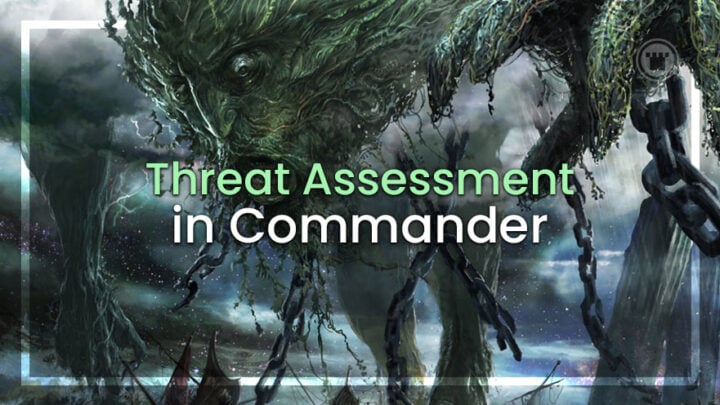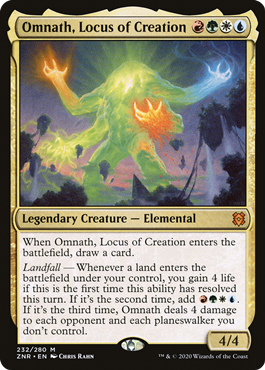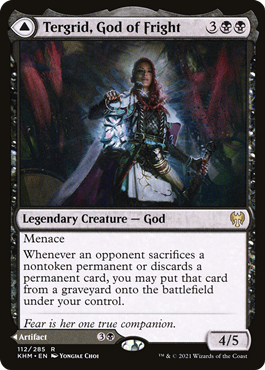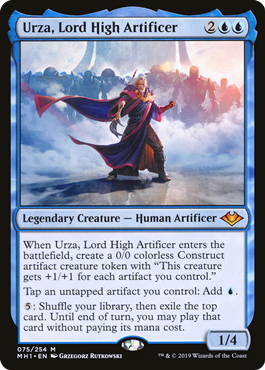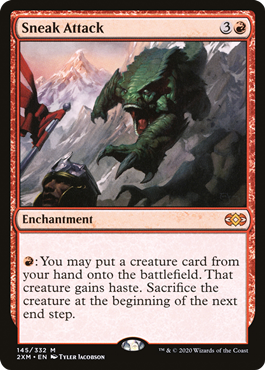Even as a social game, Commander doesn’t ask everyone playing to take up much responsibility. Knowing the basic rules of Magic and generally being a friendly person are the main baselines, but there is one more skill every Commander player should develop to keep games as enjoyable for everyone as possible: threat assessment.
For those newer to the game, threat assessment is a phrase bandied about often in the Commander community. The term describes a player’s ability to determine where their attention should be focused. And while sometimes the threat is incredibly obvious to the entire table, it’s often a very subjective, nebulous and shifting quality.
Due to that uncertain nature, it’s common for players to point their interaction at the “wrong” card or pressure the “wrong” player with attacks. When that happens, the actual threat can further develop their game plan and is more likely to win the game. Then, the “incorrectly” targeted players get frustrated that an opponent would come after them when the person next to them just took everyone out.
Over time, this friction can erode what is meant to be a fun time and turn players against each other. Nobody wants their pod or LGS torn apart, but learning how to properly threat assess is easier said than done.
It normally takes time and a lot of games — but there’s good news! I’ve played so much Commander that it became my day job, and now I can pass on my experience to those looking to learn. Here’s what to think about when you next sit down to play Commander.
Game start
Threat assessment begins before you even draw at the start of the game. As soon as you sit down and see each opponent’s commander, you should have an idea of who will be the biggest threat.
This sounds like a tall ask, and the difficulty of making this decision with so little information is why many players decide their early targets on a whim, or by rolling dice. However, I promise that identifying the first threat this early is easier than it sounds.
You should always start your threat assessment by leaning on past experiences. Like many situations in life, our ability to learn from previous adversity comes in clutch.
Start by asking yourself a few questions. Have you faced these players before? What kinds of decks do they build? How did they describe the deck during your pre-game discussion?
From there, look at the actual Commanders. Have you played any of these specific decks before? Have you seen someone else play this Commander? How did either list do?
If the cards are all unfamiliar and you’re playing with complete strangers, you can still threat assess! Read the Commanders and check for a handful of key qualities. Do they have a low mana value? Do they provide card advantage or extra mana? Are they part of any obvious combos?
Once you have the answers to these questions, consider how the decks will interact with your game plan. Remember, your opponents are assessing you at the same time you’re considering them. But if you’re a creature heavy deck and one opponent will likely play a lot of board wipes, they may move up your list of threats.
If you’re still scratching your head at this point, here are some example Commanders that can be incredibly threatening at a glance. Cards like Uro, Titan of Nature’s Wrath; Prosper, Tome-Bound; or Omnath, Locus of Creation can give your opponents crazy amounts of mana and card advantage. Creatures like Tergrid, God of Fright; Miirym, Sentinel Wyrm; and Urza, Lord High Artificer all give opponents game winning value if they untap with them in play.
Basically, if a card has you saying “oh, god…” trust your gut and keep that deck’s pilot in mind from turn one.
Early game
Despite spending all that time picking your threats before the game starts, be prepared to throw everything out the window after the first few turns. This is because Commander usually has a high level of variance, and even the scariest decks can stumble while a pre-constructed one pops off.
To determine who you need to keep your eye on, think about what everyone wants to do in the early game and consider who fits that bill. And what does everyone want to do in the early game? Set up for the win!
More often than not, setting up involves ramping — either through extra lands, mana rocks or mana dorks. After all, the more mana they can spend, the quicker they can deploy their cards. And you can always look for the heavy hitters, like Mana Crypt or Dockside Extortionist.
From there, players want to start setting up value engines that keep their plan on track. This usually means drawing cards to keep the fuel flowing, but it can also mean just building a board or dropping key artifacts and enchantments.
While every player, yourself included, will be doing this, someone will be doing it the best. They may have the most lands or a clutch of treasures. They may have exploded onto the board with a bunch of creatures or cheated out some scary “big bois” with Sneak Attack. Or, they may have played something like Demonic Tutor to grab a few sneaky piece to use later.
Once you’ve found that player, do what you can to mess them up. Attack them whenever it’s reasonable to do so. Save interaction for key cards they try to play. Hell, you can even encourage everyone else at the table to target them, too. That opponent may not like it, but heavy is the head who wears the crown.
That being said, there is a particular type of deck that deceives opponents in the early game by looking unassuming. Yes, combo decks usually go out of their way to look as non-threatening as possible because their greatest asset is simply time.
So, if an opponent is just drawing a lot of cards and trying to control the board, you may need to take them out before it’s too late. That’s why, when in doubt, I always beat up on the combo players.
Now, as I said before, keep your head on a swivel. A single change in board state can shift the game’s balance, and you don’t need to go scorched Earth on someone because they were the threat for a moment.
Midgame
Once the first few turns are over, most players should ideally have developed a board that will help them win the game. Players can start doing multiple things a turn and your answers need to be either super precise or all encompassing. This is around the time someone starts looking to go for the win.
Again, a big board is a good indicator of “the threat.” However, consider their win condition. Can they kill the table all at once? Then sure, maybe they need to go out first. But if they can only kill one player at a time, well, just make sure that person isn’t you. There may be time to stop them later.
If your target still isn’t clear after that point, consider who is doing the most on their turns. This is different from just taking a long turn, as you shouldn’t punish folks who need a little more time to think through a few key decisions (as long as it’s within reason).
I’m talking specifically about the players who spin their wheels for 15 minutes, spewing out value while inching ever closer to some critical mass. At the very least, you’ll speed the game up by removing them from the equation.
Also ,if you’ve been nice to the combo player at this point, this is about the time you want to turn up the heat. After all, with four or five turns under their belt, any decent combo deck should be halfway to winning on the spot — and all it takes is a lucky top deck to seal your fate.
Finally (and honestly), this is about when you should be the threat yourself if you want to win. As a result, threat assessment shifts from “who is close to winning?” to “who is stopping me from winning?” Look for the players with lots of open mana, or the players who are stubbornly stuck in your way. Hamstringing them, or taking them out entirely, can make dealing with the rest of the table a trivial matter.
Endgame
This section will be fairly short, because if you’ve reached this point without losing, one of a few things are probably true:
- It’s too late to stop either you or an opponent. The table may thrash against their cruel fate, but someone’s victory is only a matter of time.
- At least one (and maybe two) players are already out of the game. It turns out threat assessment gets much easier when there are less people to point at.
- You are in a grindy slugfest where everyone is so spent that all they can do is slowly trade blows until someone top decks their way to victory or loses the war of attrition.
In scenario one, your threat assessment rarely means much — so just have fun! Go for the big hail mary play or make the funniest move. Odds are none of your decisions will significantly impact the game, and it’s fine to wrap things up in the most satisfying way possible for you.
In scenario two, while it’s easy to pick the problem player, threat assessment is more about specific cards. Basically, ask yourself “will that card let my opponent win the game if it resolves?”
If the answer is yes, throw every resource you can at answering it (think cards like Torment of Hailfire or Blightsteel Colossus). If the answer is no, accept whatever beats may be coming your way. The only plays that matter here are the game winning ones, and it’s common for players to bait each other into spending valuable answers so they can close the door.
Meanwhile, scenario three is somewhat similar to scenario two — but on a smaller scale. If everyone left is empty handed with limited boards, focus down the player with the best shot of rebuilding. This often loops back around to your early game considerations, as the one cards players will almost always have access to is their Commander. However, a big spell off the top can be just as impactful.
Either way, you’re working with thin margins. Just do your best and take whatever comes as a lesson for the future.
End step
There’s a lot to threat assessment in Commander, obviously, but this should give you a solid foundation. At the same time, remember that it takes time to put all of these lessons into practice. After all, in the heat of the moment, sometimes our feelings take over and lead us astray.
Don’t feel bad when you slip up, and don’t let anyone make you feel bad for a bad decision. Just reflect on what went wrong, own the fact that you’re still learning and remind everyone involved that you can all just play another game. That’s the beauty of Magic.
Anyway, hopefully this is helpful and accurate! If you think my assessment of threat assessment is way off base, let me know. I’m happy to practice what I preach on Twitter.

Jason Krell is the content manager at Card Kingdom, meaning he helps make all of this possible. He is also an unabashed Esper control player, and he hopes the two things at least cancel each other out. He loves when everyone gets to do their thing in a game of Commander and spends way too much thinking about game design. Jason also comes from an esports journalism background, which probably explains a lot about his work.

